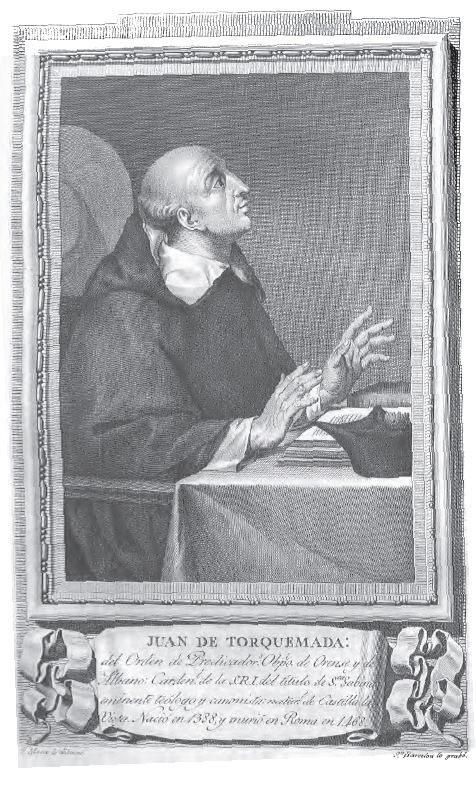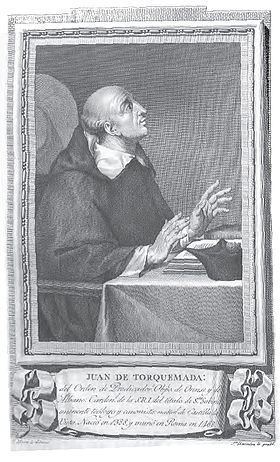Name Juan Torquemada | Role Cardinal | |
 | ||
Books A Disputation on the Authority of Pope and Council | ||
Juan de Torquemada, O.P. (1388 – 26 September 1468), (church Latin Johannes de Turre cremata, various spellings), Spanish ecclesiastic, was born at Valladolid, and was educated in that city.
Contents

Life
Juan de Torquemada was born in Valladolid, Spain. At an early age he joined the Dominican Order, and soon distinguished himself for learning and devotion. In 1415 he accompanied the general of his order to the Council of Constance. Thereafter he proceeded to the University of Paris for study, and took his doctor's degree in theology in 1423. After teaching for some time in Paris, he became prior of the Dominican house in Valladolid, and then in Toledo.
Torquemada attended the Council of Basel (1431–1449) as a representative of his order and of the King of Castile. At the Council of Basel he was one of the ablest supporters of the viewpoint of pope Eugene IV and the Roman curia. He was rewarded with the office of Master of the Sacred Palace (4 March 1435), and later with a cardinal's hat in 1439. Torquemada participated in the Council of Florence, speaking on theological issues involving the eastern churches and defending papal primacy in a debate with Cardinal Giuliano Cesarini. He also worked on behalf of Pope Eugene on missions to Germany and France before settling in the Roman curia. As Cardinal of San Sisto, Torquemada supported papal Crusade policy in opposition to the Ottoman Turks. He also defended the conversos of Toledo against accusations that they were not true Christians. (Juan de Torquemada was an uncle of the Inquisitor, Tomás de Torquemada. The latter's fear of "crypto-Jews" might derive from his uncle's defense of the converso community of Toledo.) Torquemada promoted reform of religious houses of his order and of monasteries. In 1456, the new Pope Callixtus III, aka Alfonso de Borja, gave him, in commendam, the position of Abbott of the monastery of Santa Scolastica in Subiaco. This connection may explain his interest in the importation of printing into Rome. The cardinal wrote extensively on behalf of papal primacy. Most notably, his Summa de ecclesia defended the Church against the Hussites and the Roman pontiff against conciliarism.
Torquemada became cardinal priest of Santa Maria in Trastevere (1446-1460), then cardinal bishop of Palestrina (1460-1463), and last cardinal bishop of Sabina (1463-1468). He participated in four papal elections, casting the deciding vote in the election of Pope Nicholas V (1447–1455). He died at Rome in 1468 and was buried at Santa Maria sopra Minerva.
A painting by Antoniazzo Romano showing the Annunciation has in its background Torquemada presenting girls who received dowry funds from a guild he founded to the Virgin Mary. (At an earlier age he was painted by Fra Angelico in a Crucifixion scene now at Harvard University's Fogg Museum.)
Works
Torquemada's principal works are:
The Summa de ecclesia has the following topical books:
- De universa ecclesia
- De Ecclesia romana et pontificis primatu
- De universalibus conciliis
- De schismaticis et haereticis - divided into two parts, on schism & on heresy.
His De conceptione deiparae Mariae, libri viii. (Rome, 1547), was edited with preface and notes by E. B. Pusey (London, 1869 seq.) in opposition to Pope Pius IX's definition of the dogma of the Immaculate Conception.
Other works include polemical tracts and sermons.
Torquemada's Meditationes was the first illustrated book published in Italy. The first edition of the book was published in 1467 in Rome by Ulrich Han.
